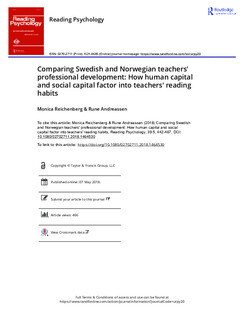| dc.contributor.author | Reichenberg, Monica | |
| dc.contributor.author | Andreassen, Ulf Rune | |
| dc.date.accessioned | 2019-05-31T09:44:29Z | |
| dc.date.available | 2019-05-31T09:44:29Z | |
| dc.date.created | 2018-07-12T12:29:40Z | |
| dc.date.issued | 2018 | |
| dc.identifier.citation | Reading Psychology. 2018, 39 (5), 442-467. | nb_NO |
| dc.identifier.issn | 0270-2711 | |
| dc.identifier.uri | http://hdl.handle.net/11250/2599515 | |
| dc.description.abstract | The present study compares how Swedish (n = 340) and Norwegian (n = 236) teachers' human capital and social capital support reading habits as an aspect of professional development. The overall aim was to describe how teachers' human and social capital support their professional development as measured by the aspect of reading habits during leisure time. Our research questions were: To what extent do Swedish and Norwegian teachers differ in their reading habits during leisure time? To what extent do young and old Swedish and Norwegian teachers differ in their reading habits during leisure time? To what extent does Swedish and Norwegian teachers' social capital (collegial talk, principal talk) predict their reading habits during leisure time? To what extent does Swedish and Norwegian teachers' human capital (based on their age, education, and work years) predict their reading habits during leisure time? We compared teachers' reading habits between countries. Older teachers read, on average, more fiction, nonfiction, and newspapers. However, younger teachers in both countries are more prone to read digital texts than older teachers. By contrast, teachers' social capital only seemed to matter in Sweden, while talks with the principal had no effect in either country. | nb_NO |
| dc.language.iso | eng | nb_NO |
| dc.publisher | Taylor & Francis | nb_NO |
| dc.rights | Attribution-NonCommercial-NoDerivatives 4.0 Internasjonal | * |
| dc.rights.uri | http://creativecommons.org/licenses/by-nc-nd/4.0/deed.no | * |
| dc.title | Comparing Swedish and Norwegian teachers' professional development: How human capital and social capital factor into teachers' reading habits | nb_NO |
| dc.type | Journal article | nb_NO |
| dc.type | Peer reviewed | nb_NO |
| dc.description.version | publishedVersion | nb_NO |
| dc.subject.nsi | VDP::Samfunnsvitenskap: 200::Pedagogiske fag: 280 | nb_NO |
| dc.source.pagenumber | 442-467 | nb_NO |
| dc.source.volume | 39 | nb_NO |
| dc.source.journal | Reading Psychology | nb_NO |
| dc.source.issue | 5 | nb_NO |
| dc.identifier.doi | 10.1080/02702711.2018.1464530 | |
| dc.identifier.cristin | 1596890 | |
| cristin.unitcode | 224,30,0,0 | |
| cristin.unitname | Avdeling for lærerutdanning | |
| cristin.ispublished | true | |
| cristin.fulltext | original | |
| cristin.qualitycode | 1 | |

